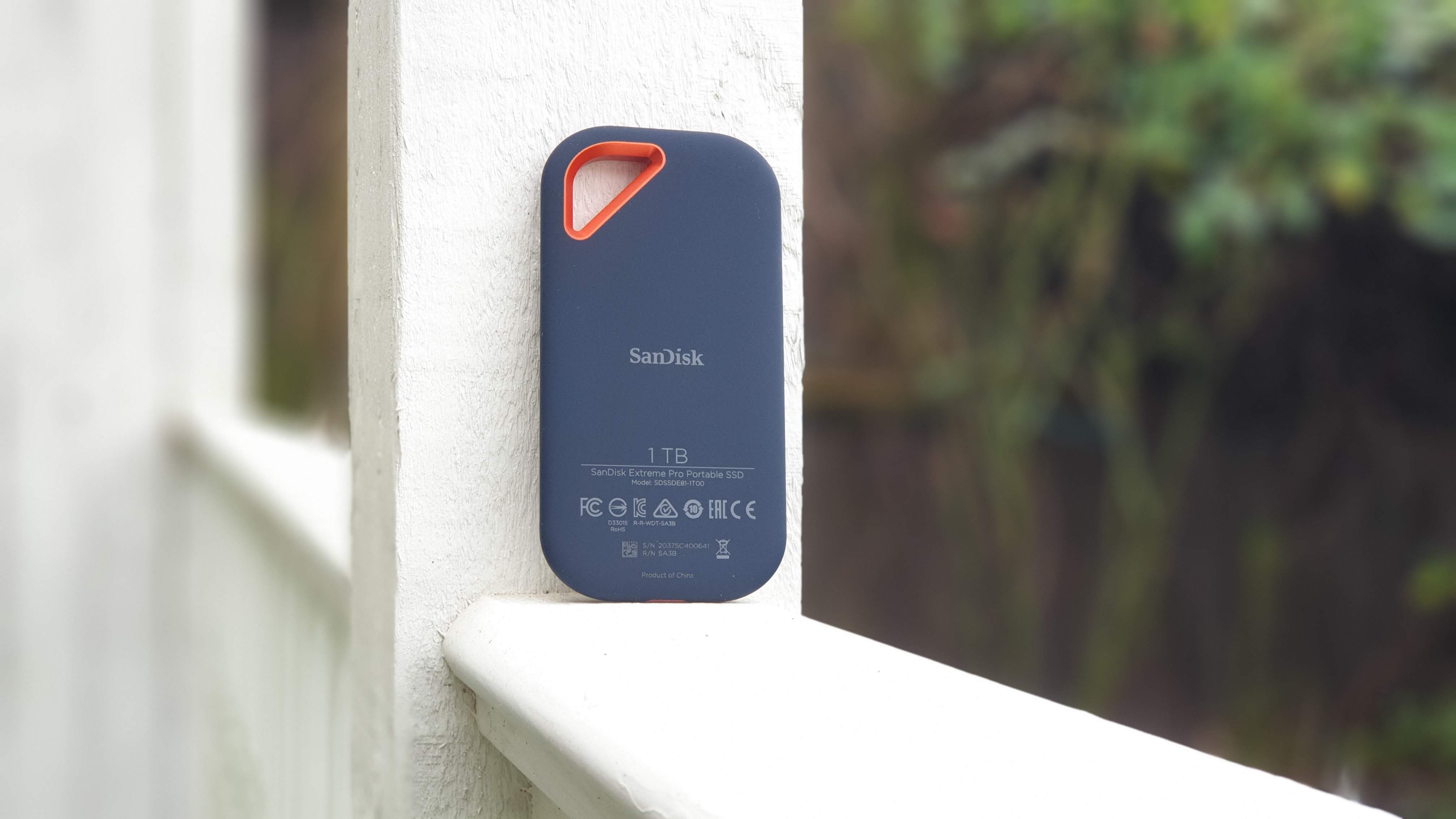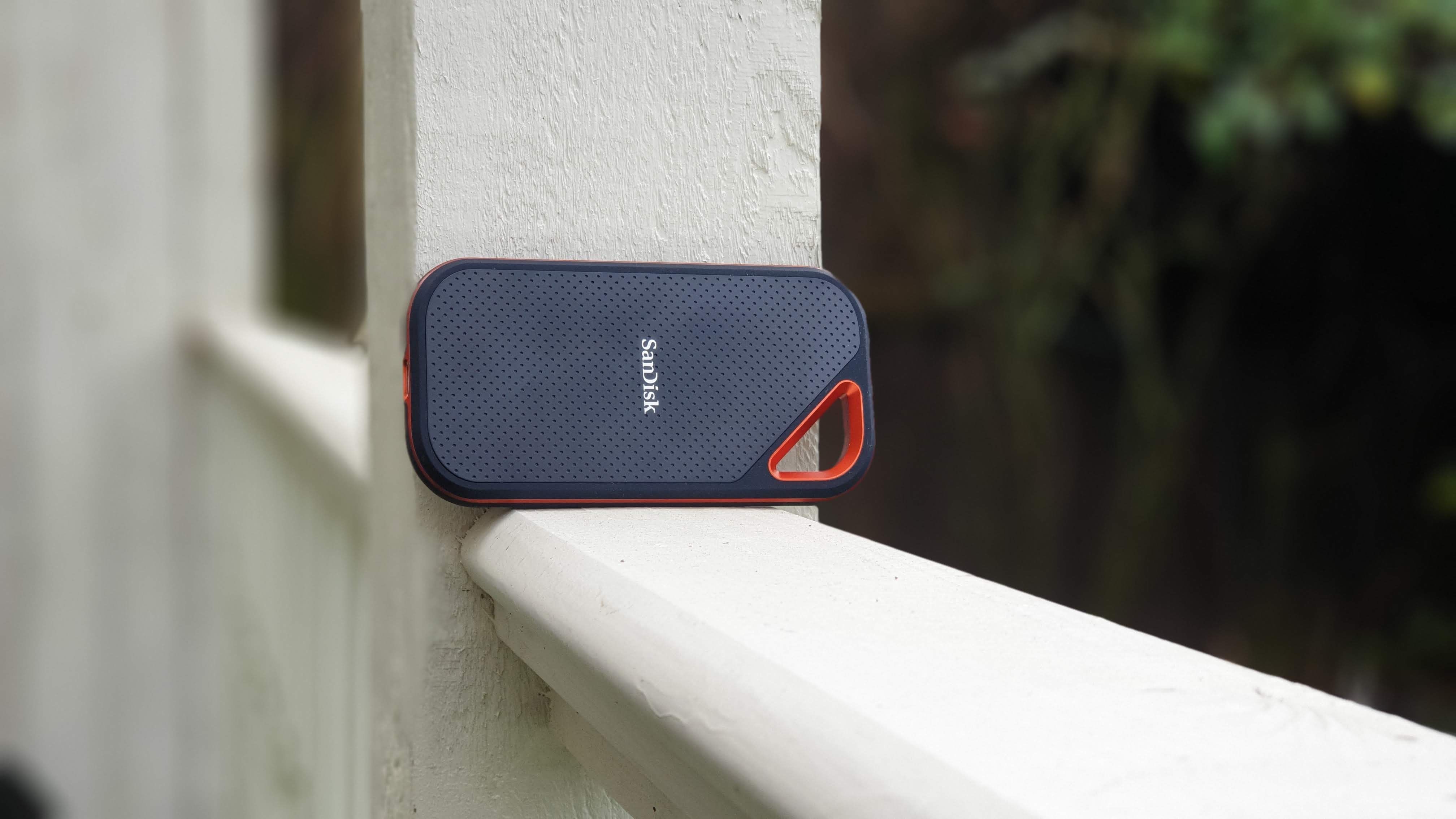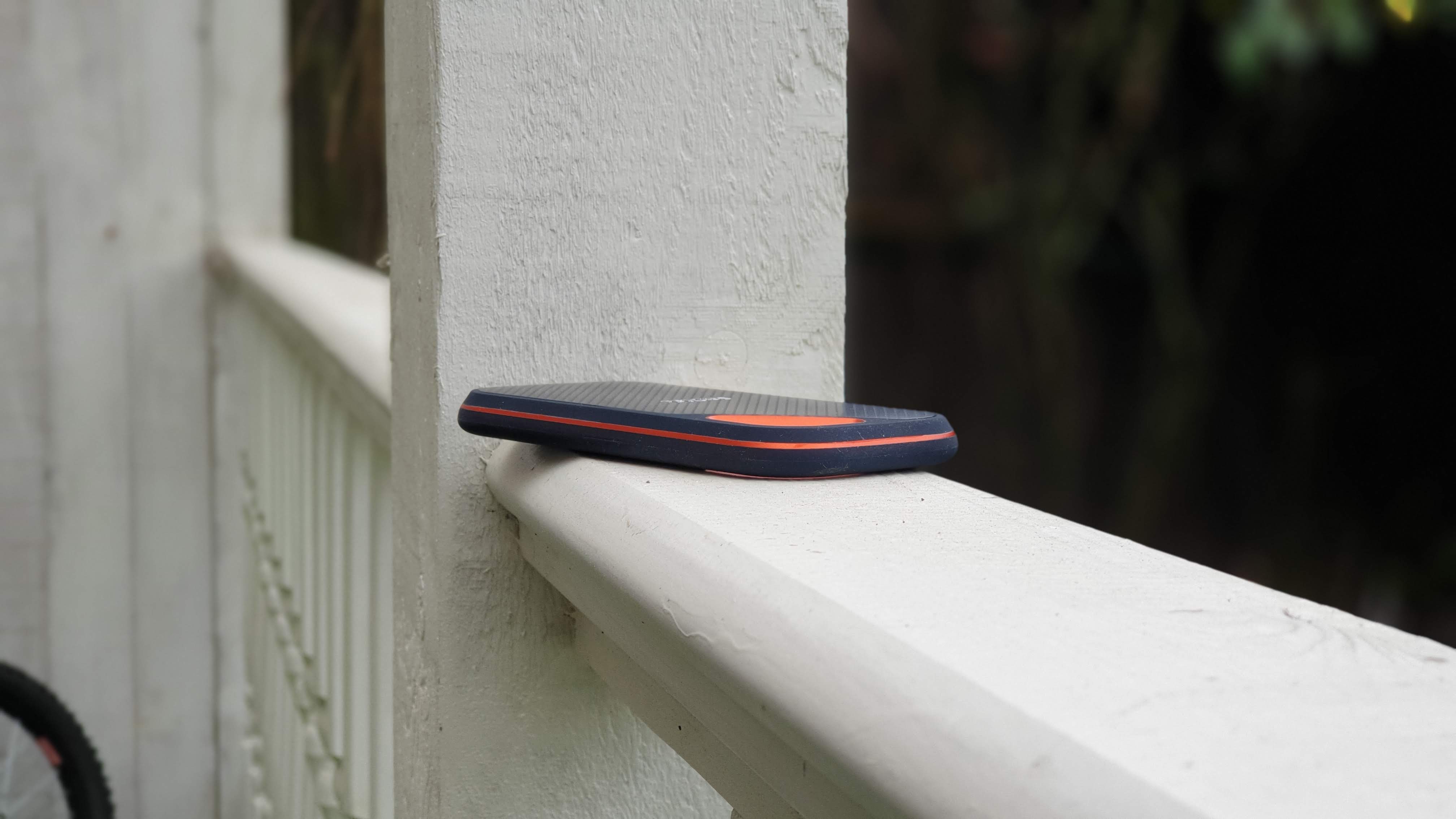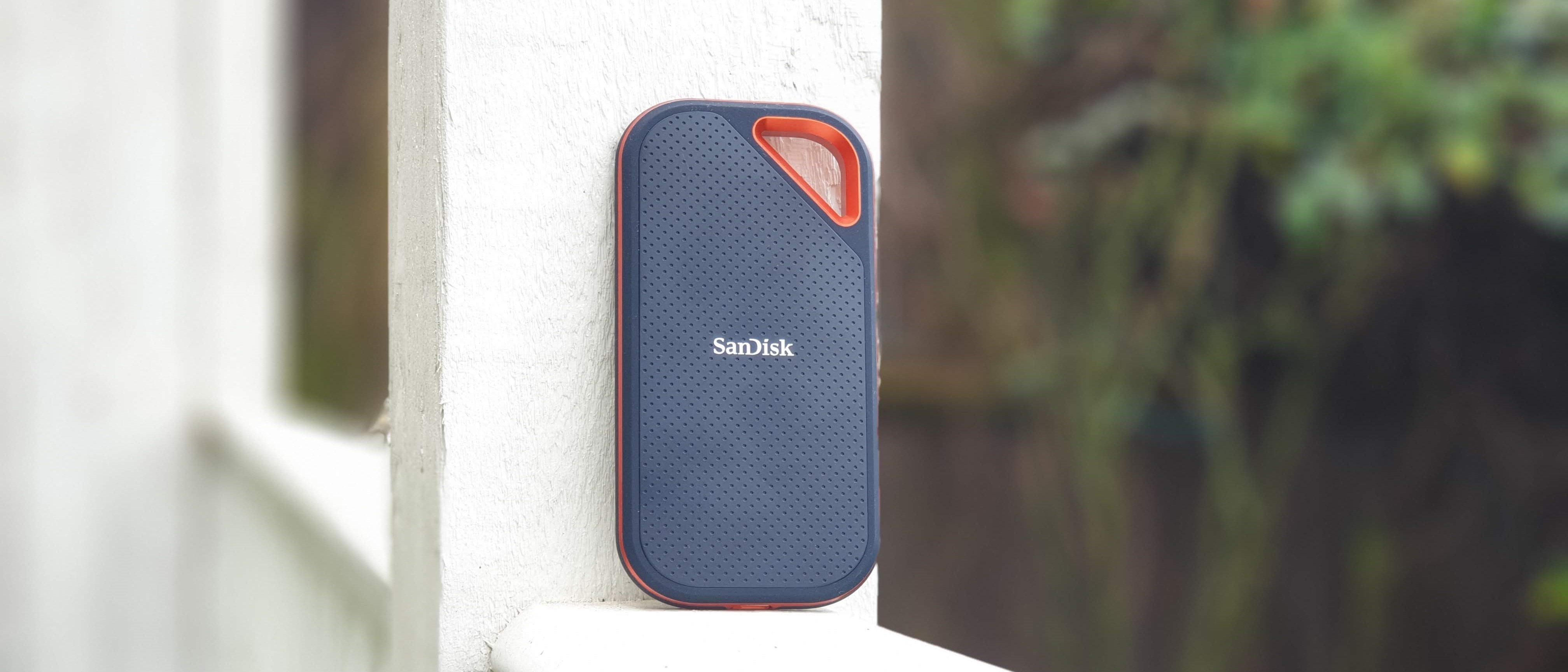TechRadar Verdict
Sandisk produced an excellent all-rounder storage device that, on paper at least, is the fastest rugged storage device on the market. The problem is that its potential is shackled by the fact that there are few compatible devices on the market.
Pros
- +
5 year warranty
- +
Phenomenal performance
- +
IP55 rating
- +
Solidly built
- +
Hardware encryption
Cons
- -
You need a compatible device to benefit from the speed boost
- -
More expensive than faster Thunderbolt 3 models
- -
Shortish cables
Why you can trust TechRadar
Sandisk has rolled a third version of its award winning Extreme portable rugged solid state drive, one that sports a distinct orange carabiner loop. Confusingly, it looks exactly the same as the other Extreme products, the original Extreme Portable and the original Extreme Pro Portable. The model that we received is the Extreme Pro Portable SSD v2 (SDSSDE81-1T00-G25) with a 1TB capacity and a USB 3.2 Gen2x2 interface, making it, in theory, the fastest rugged USB storage to date.
Note that a 4TB version of this drive was launched in January 2021 at CES 2021 with a significantly higher price to reflect its premium status.
Price and availability
The original Extreme Portable SSD is still available for sale; the 1TB and 2TB models cost $130 and $230 respectively. The faster Extreme Pro Portable (v1) retails for $180 and $330 while the corresponding v2 units sell for $230 and $350 respectively.
- Also check out our roundup of the best external hard drives

Design and features
No surprise here, the Extreme Pro adopts the same form factor and material as the Extreme and the Extreme Pro. Designers used a forged aluminum chassis-silicon shell combination to offer what Sandisk calls “a premium feel with added protection”. The textured skin gives it a sporty look while the enclosure acts like a heatsink to dissipate heat generated by the internal components.

The drive, like its predecessors, is IP55-rated and can withstand a 2m drop; there’s a metal carabiner loop for securing your belt or backpack. Unlike some of its rivals, it doesn’t offer a flap to protect the exposed port so it will unlikely survive being thrown in water.

It is portable without being tiny; its physical dimensions (57 x 110 x 10mm) and its weight (85g) make it reasonably compact to be carried around unnoticed. Note that it comes with two 30cm USB cables rather than a cable and an adaptor as in the 2018 iteration of the drive; one has a Type-C end, the other a Type-A connector.

Hardware and performance
The NVMe drive is based on the ASMedia ASM2364/SanDisk 20-82-007011 bridge/controller pair and uses SanDisk BiCS 4 96L 3D TLC NAND.
The Extreme Portable Pro SSD comes pre-formatted as an exFAT device which means that it can work on Windows and Mac out of the box. Reformatting it to NTFS file system will limit compatibility to Windows but will enable TRIM which will improve the longevity of the drive.
Here’s how the Sandisk Extreme Pro V2 portable SSD performed in our suite of benchmark tests:
CrystalDiskMark: 1052MBps (read); 1034MBps (write)
Atto: 1006MBps (read, 256mb); 994MBps (write, 256mb)
AS SSD: 873MBps (seq read); 821MBps (seq write)
AJA: 812MBps (read); 832MBps (write)
You will need to have a compatible host device to make the most out of this Extreme Pro v2. Sadly, we didn’t have anything at hand to test its claimed performance. We suspect that a lot of potential customers will buy the drive and expect read/write speeds of up to 2GBps (as per the numbers on the box).
They will be lucky to reach even 55% of that number which puts it slightly ahead of the Extreme Pro Portable (v1) and could explain the relatively modest price premium between the two (remember, it’s only $20 for the 2TB model).
We tested the Sandisk Extreme Pro 1TB external portable SSD using a Dell Latitude 7490 business laptop which is equipped with a Thunderbolt 3 port. Note that the Extreme pro Portable SSD v2 includes support for hardware encryption via the Sandisk SecureAccess application.
Our tests show that the Sandisk Extreme Pro V2 performs on par with current USB 3.2 Gen 2 drives and that’s not a surprise. CrystalDiskMark, for example, hit more than 1GBps on sustained read and write speeds using default settings.
The competition
The Sabrent Rocket XTRM-Q ($200 for 1TB, $350 for 2TB) might not be a USB 3.2 Gen2x2 drive but its Thunderbolt 3 interface means that it can reach much higher speeds than the Extreme Pro V2 if you have a compatible port. Luckily, a lot of high-end laptops and desktops come with that port and it is likely to grow in popularity thanks to the fact that Intel has opened the platform, lowering the cost of adoption and offering a more standardized approach to data transfer. It is not rugged or compact or water resistant though.
The WD_Black 1TB P50 shares some of the same internals as the Sandisk Extreme Pro V2 as they’re part of the same company but uses more premium SanDisk BiCS 3 64L 3D TLC NAND. It has an industrial feel to it thanks to a carefully chosen design that WD says will appeal to gamers. Pricewise, it costs the same as the aforementioned Sabrent and therefore cheaper than the Extreme Pro.
Final verdict
The Extreme Pro will appeal to a particular niche, one that craves for speed and wants something that is portable and can withstand more than a few bumps. It comes with a five-year warranty and its size and weight will turn it into a favourite storage companion especially with the hardware encryption.
But there’s a problem; while there are plenty of add-on cards (and a handful of motherboards) that support the technology, we are not aware of any laptop, desktop PC or docking station that offer a USB 3.2 Gen2x2 port. That compares poorly with the tens of millions of devices that are natively compatible with Thunderbolt 3. The size of the addressable market is probably a couple of orders of magnitude bigger.
So you’re left with a conundrum: Buy a storage device that promises to be extremely fast but only in certain circumstances or get one of the many rugged USB 3.2 Gen 2 drives available for significantly less but will work with far more devices.
- We've also highlighted the best portable SSD

Désiré has been musing and writing about technology during a career spanning four decades. He dabbled in website builders and web hosting when DHTML and frames were in vogue and started narrating about the impact of technology on society just before the start of the Y2K hysteria at the turn of the last millennium.
